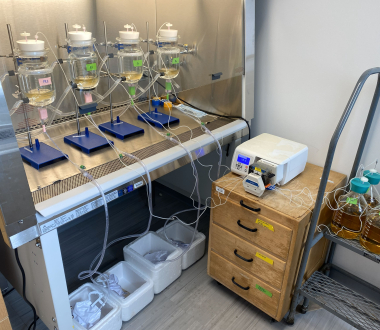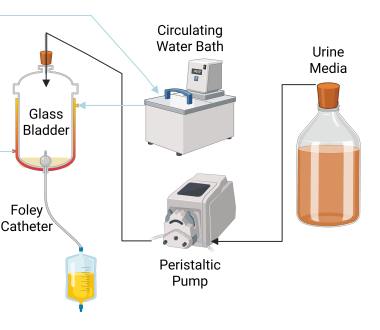

Glass bladder model setup used in this study, with five bladders running in tandem. Schematic representation created in BioRender (Guterman, B. https://BioRender.com/0d8si2e), adapted from Benjamin, C.H. et al., mBio 0, e02164–02124 (2024).
Dr. George Donati, Deputy Director of the Laboratory of Inorganic and Nuclear Chemistry at the Wadsworth Center, recently co-authored a study led by Professor Chelsie Armbruster of SUNY Buffalo. The research, published in Nature Communications on November 3, 2025, is titled “Harnessing microbial-derived metabolites in the urinary tract to prevent infection-induced catheter encrustation.” The study investigates how naturally occurring microbial metabolites in urine can help prevent catheter encrustation and biofilm formation—two major drivers of catheter-associated urinary tract infections (CAUTIs).
The work is focused on developing alternatives to combat Proteus mirabilis, one of the most common pathogens responsible for CAUTIs. This bacterium produces urease, an enzyme that elevates urinary pH and leads to the formation of salt crystals. These crystals contribute to urinary stones, catheter blockage, and potentially life-threatening bloodstream infections. Given the high incidence and mortality of UTIs, the search for effective preventive strategies is of significant clinical importance:
- CAUTIs are the most common hospital-acquired infections in the United States.
- More than 13,000 U.S. healthcare-associated deaths each year are attributed to UTIs, and roughly 75% involve urinary catheters.
- Between 15–25% of hospitalized patients receive urinary catheters during their stay.
Current treatment options are limited. The only FDA-approved drug targeting P. mirabilis colonization—acetohydroxamic acid—has substantial side effects, restricting its use. The study explored whether metabolites naturally produced by other microorganisms in the urinary tract could counteract P. mirabilis activity and reduce crystalline biofilm formation.
Using an untargeted metabolomics approach coupled with high-performance liquid chromatography tandem mass spectrometry (HPLC–MS/MS), the researchers identified 307 microbial-derived metabolites, seven of which showed activity against P. mirabilis and other Gram-positive bacteria. In vitro experiments demonstrated that combining low doses of acetohydroxamic acid with two of these metabolites significantly reduced crystal formation. Notably, histamine enhanced the activity of both the FDA-approved drug (at a reduced dose) and a low-dose antimicrobial when used in combination.
Key advantages of the strategy described include:
- Microbial metabolites can prevent catheter blockage while enabling lower—and potentially safer—doses of existing FDA-approved treatments.
- Metabolite combinations can increase the effectiveness of antimicrobial agents, reducing the burden of CAUTIs.
- A metabolite “cocktail” may substantially improve outcomes for patients requiring long-term catheter use.
- Future applications include the development of catheter flush solutions and catheter coatings designed to prevent bacterial colonization, blockage, and associated morbidity and mortality.
Reference: L.B. Guterman, M. Motsay, B.C. Hunt, A.L. Brauer, B.S. Learman, M.K. Wijayahena, A.C. Hoepker, D.S. Aga, B. Francis, B.M. Fontoura, G.L. Donati, P.J. Bush, N. Deka, C.E. Armbruster. Harnessing microbial-derived metabolites in the urinary tract to prevent infection induced catheter encrustation. Nature Communications 16 (2025) 9678. https://doi.org/10.1038/s41467-025-64661-y
https://www.nature.com/articles/s41467-025-64661-y#rightslink
Open Access: this article is licensed under a Creative Commons Attribution 4.0 International License (https://creativecommons.org/licenses/by/4.0/).